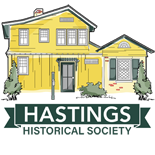
by Keith Doherty
The Dunn House at 5 Pine Street in Hastings-on-Hudson is one of the best-preserved early homes in the village and in the Uniontown neighborhood to which it belongs. It is a prime example of home-grown architecture of a sort very common in the United States in the 19th century, developed and refined over many decades by legions of semi-skilled craftsmen. Although heavily renovated on the interior, today it is largely unaltered on the outside and preserves the look and feeling of the original Uniontown development perhaps better than any other early structure still standing in the area.
The Early Years
Its original owner was an Irish immigrant named Richard Dunn, who purchased the lots for $450 at an auction held in 1874 by the estate of Sidney Blackwell, an early real estate mogul in the area. The auction was aimed specifically at immigrants like Dunn, who by the early 1870s were making up an increasingly large part of the village’s population. They had been drawn to the village because of growing industrial operations, such as the marble quarry just off the Croton Aqueduct and the Hudson River Steam Sugar Refinery on the riverfront.

The property was located near the top of the hill in Uniontown, which was one of the last parts of the neighborhood to be settled due to a lack of accessibility. Although Dunn purchased the lots in 1875, the house itself does not seem to have been built until around 1900. This was probably accomplished by Richard’s brother Maurice (pronounced “Morris”), to whom the property was sold in 1880. Little is known about Richard and Maurice, other than that they were Irish immigrants who had four and three children, respectively. In early censuses, Maurice is listed as a carpenter and Richard as a gardener. Historical Society records indicate that the latter was in the employ of Robert Behr, who owned an estate on Broadway where the Hastings Landing townhouse complex stands today.
Structures like the Dunn house were typically built by the owners themselves and a coterie of semi- or unskilled friends or associates working for free (or perhaps a meal and a beer or two), and this was likely the case at 5 Pine Street. The traditional balloon-frame armature (i.e., consisting of a simple wooden matrix of 2 X 4’s supported by two thick load-bearing exterior walls), the simple fieldstone foundation, the deep front porch, and the saltbox extensions off the rear are all trademark features of the earliest homes in Uniontown. The Dunn house was somewhat grander in scale than most, spanning three of the original lots. In this respect, it must have seemed like a palace to those who built it and others in the neighborhood.


Very shortly after its construction, the house was modified into a two-family affair, with a very similar arrangement of features doubled laterally (a type of modular extension very common in 19th century American folk architecture). Early maps suggest that it was originally a one-family home consisting of the northern half only, with the southern half and its rear extension added sometime between 1902 and 1912.


That the two halves were completed relatively close together in time is supported by the similarity of materials and construction techniques on both sides. The original property would have been heated by a coal stove (with coal delivered to the basement via the hatches still extant on either side of the house) and its water drawn from a well.
The Dunn Family
Descendants of the two brothers still live in the village and in parts of Yonkers. Maurice had a son that was also named Richard – named perhaps after his uncle – with the middle initial of “T.” (for Thomas), who we know lived in the house into early adulthood. We get this information thanks to an interview with Richard T. Dunn’s granddaughter Janet Murphy, a long-time employee of the Hastings Public Library and a trustee of the Hastings Historical Society.
From Janet, we also learn that Richard T. Dunn (known to many as “Dick”) was a police officer in the village, a devout member of St. Matthew’s Roman Catholic parish, and the father of seven. He was also a volunteer fireman in the Uniontown firehouse for many years, switching his allegiance to Protection Engine Company after the family moved from Uniontown to Maple Avenue.


In his spare time, Dick worked tirelessly to improve the lots of Irish, Italian, and Polish immigrants in what in his lifetime had become an industrial town largely populated by poorly-educated foreign workers. A literacy volunteer before such a thing existed, he spent his nights going door to door teaching English to primarily Italian immigrants. Once he felt they were competent speakers, he coached them on the U.S. citizenship exam, and even drove them to White Plains to take it (which he was able to do as one of the first people in the village to own a car).
Dick Dunn’s work is especially significant in the context of Hastings in the late 19th and early 20th centuries. This was a time of discrimination against immigrants on the part of the local gentry, who often looked down on them as uncultured and even dangerous intruders. Village records reveal attempts to segregate the immigrant population through the establishment of separate educational facilities and other means. By educating and ensuring the citizenship of immigrant workers, Dick did much to integrate struggling immigrants into the fabric of “respectable” Hastings and American life in general.
In addition to his literacy work, after his retirement Dick and his wife Nora opened an extremely successful restaurant in the heart of the village. The business operated at 7 Spring Street, in the building now occupied by Food for Thought. Called “Dunn’s Restaurant” during Prohibition, it became “Dunn’s Bar and Grill” once the law was repealed. The Dunns catered primarily to factory workers, who trudged up the hill to the tavern after their shift ended, seeking a meal and a libation or two. Dinner was popular with families as well, with some folks making the trip up from Yonkers.

Unfortunately, Dick died quite young of kidney disease. This occurred in 1929, not long after the restaurant opened, leaving it up to Nora to run the establishment. She accomplished this with help from the extended family and a few hired hands. An Irish immigrant herself, who had experienced deprivation as a child, Nora cherished the idea of being able to make and sell food to hungry patrons. Among other things, she gave free lunches to local immigrant schoolkids whose parents couldn’t afford to provide them with a hearty meal. Nora eventually married again, to Louis Wolf, and the establishment was named Wolf’s Bar and Grill for a short time. After Louis Wolf’s death, her sons from her first marriage took it over and the name reverted back to Dunn’s.
The Pine Street House Today
During recent maintenance on the home, current owner Ron Cohen discovered two fully intact beer bottles in the soil just to the rear of the kitchen and dining area. One of these bears the logo “Chas. Bevers Brewery, Hastings, NY.” This brewery operated out of the International Hotel, an establishment located in Hastings on the riverfront from 1877 to about 1910 that catered to itinerant factory workers. The dating suggests that the bottle was left in the ground during the initial construction or extension of the home, perhaps by Maurice Dunn or one of his co-builders. A great many other, less well-preserved objects from around this time have also been discovered by Ron on the southern perimeter of the property.

Internally, the home was gutted and heavily renovated in the 1950s. The changes were significant, making it difficult to guess exactly what the layout was like originally. To be sure, there would have been more partition walls and smaller rooms, and bedrooms would have had no closets. Ceilings, too, may have been lower; these were typically no more than 7-8 feet high in early Uniontown homes to conserve heat.
Certain features, however, observed in the southern portion of the structure betray the early date of the house. These include the extremely steep incline of the staircases, especially the one leading to the basement, and the remnants of another staircase now lodged inside a closet in an upstairs bathroom. The doorway leading to the basement off the kitchen also has a curiously low lintel (support beam), suggesting a once lower ceiling.
Taken together, these elements paint a portrait of a home that is a veritable time capsule of local history; a metaphor in wood and stone for the immigrant experience in Hastings during its period of rapid industrial growth in the late 19th and early 20th century. Architecturally, it is a wonderful example of a homespun building practice that – for all its apparent lack of refinement and professionalism – has a stoic beauty all its own.
Keith Doherty is a lifelong resident of Hastings and a graduate of Hastings High School. He earned a doctorate in Art History from Boston University in 2009. He would like to thank Hastings residents Ron Cohen, owner of the local realty firm Rivertown Rose, for providing access and information on his house, and Janet Murphy, for her help on the history of the Dunn family.










Keith, we lived at 16 Croton Ave. from 1951-1994. All of us Lillards went through the Hastings school system. Like you, my mother was an Art History major, was Chairman of the Art and Fashion departments at Pratt from 1946-1970. Your article was quite enjoyable. Thanks! Jon Lillard, Easton, Maryland, HHS class of 1963, class rep.
Great article about the Dunn’s and “ Dunn’s Bar & Grill.
Back in The 60s and 70s when the two brothers Dick and Frank Dunn operated the bar It was quite an enjoyable place to have a drink and conversation mostly with the bartenders Frank and Dick. Two better gentlemen, you could not find , they had a distinct talent. They were widely respected as the sports “ Guru’s “ of bartenders
in the village. this was long before sports talk radio obviously which they could’ve run their own podcast from the bar if it was today 😊They we’re literally walking encyclopedias on any sports subject, mostly baseball basketball football and boxing. If you had a disagreement or an argument over sports question you went to Dunn’s to get the answer. They wouldn’t take telephone calls. They prefer you come to the bar and at least buy a beer before they would give you the answer, back when they operated the establishment it was pretty much a bachelors, encampment woman you’re not allowed unless they were escorted by a man. Many was the evening I closed the bar along with one or two other patrons with either Frank or Dick watching the Johnny Carson show, great memories. PS there were no pictures attached to this article at least I didn’t see any to download?
Thanks Jon, and thanks JJ for bringing the experience of being in the bar to life!
What a terrific piece, connecting the present to the past. Finding staircases and artifacts in the lawn, as well as the construction methods offer a glimpse of a different time. Thank you, Keith!
Thank you for a great article… While it’s about my family, most of the information was new to me. (I will take up, separately, with my cousin, Janet, why she never told me any of this previously!! ) Loved seeing that old picture of the Dunn family… it predates the birth of my mother (Dorothy) but was great to see my aunts and uncles in their youth… They were all class people… JJ captured my uncles and the vibe at Dunn’s perfectly… (btw, JJ, i remember you well… as an underage kid, my uncles would insist i sit ‘off the bar’ as i nursed a coke, while my father, Charlie Bingham, either drank or bartended!)… i would just add the married names of the Dunn ‘girls’ as there are still many a ”Dunn’ in town (or Dobbs Ferry) to this day…. Eileen Audevard, Lenora Graham, Martha Murphy, Lois Maher, Dorothy Bingham… In fact, i once played in a Hastings/Dobbs baseball game with 5 of the 18 players were Dunns! Very fond memories.
Really interesting history, Keith!
Great job on this, Keith. As someone who knows a lot of the Dunns, it was an incredibly interesting read. And I knew almost none of this. I knew a lot about Dunn’s Bar and Grill, and went there a few times in my youth before it closed. But knew nothing about 5 Pine Street and the history of the Dunns at that house.
Most enjoyable Keith. Brought back many memories. I used to live at 23 Croton Avenue from 1928 up until 1945, and then again from the late 50s until 1970.
Ed Dannenberg, Osprey, Fl.
I remember Mr. Dannenberg very well. Probably Ed’s father. I grew up at 16 Croton starting in 1951, age 5. I remember that Mrs. Dannenberg I believe was a nurse who responded to the 1917 massive munitions explosion in Nova Scotia and travelled by train up there to help the wounded .
Ed, was your mother Thelma… a dear friend of Dorothy Dunn Bingham?
Yes she was Mark. And regarding Jon’s comment, Mom was a nurse during WW1 and she was sent to Halifax after the explosion of an ammo ship in the harbor in 1918.
Fantastic story!
Thanks everyone for the comments.
Hi iv just found this article while researching my family tree here in Ireland. Nora Dunn or Hanora Naughton as she was born is my great great aunt I’d love to get in contact with any members of the family that would like to make contact. If you could please facilitate that would be amazing. Thank you in advance for your time and this amazing article.
Yours greatfully
Mary O’Brien
Sligo Ireland